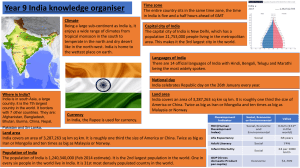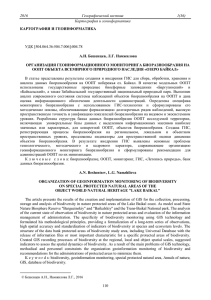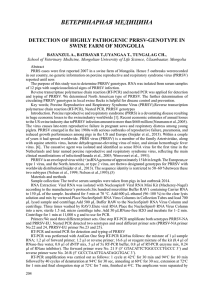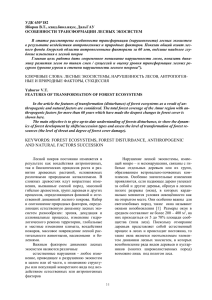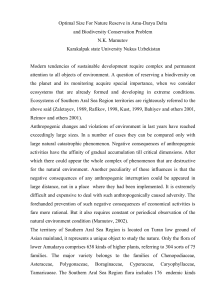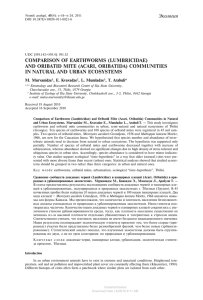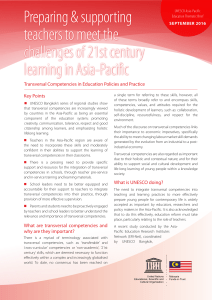гап-анализ для охраны биологического разнообразия и
Реклама
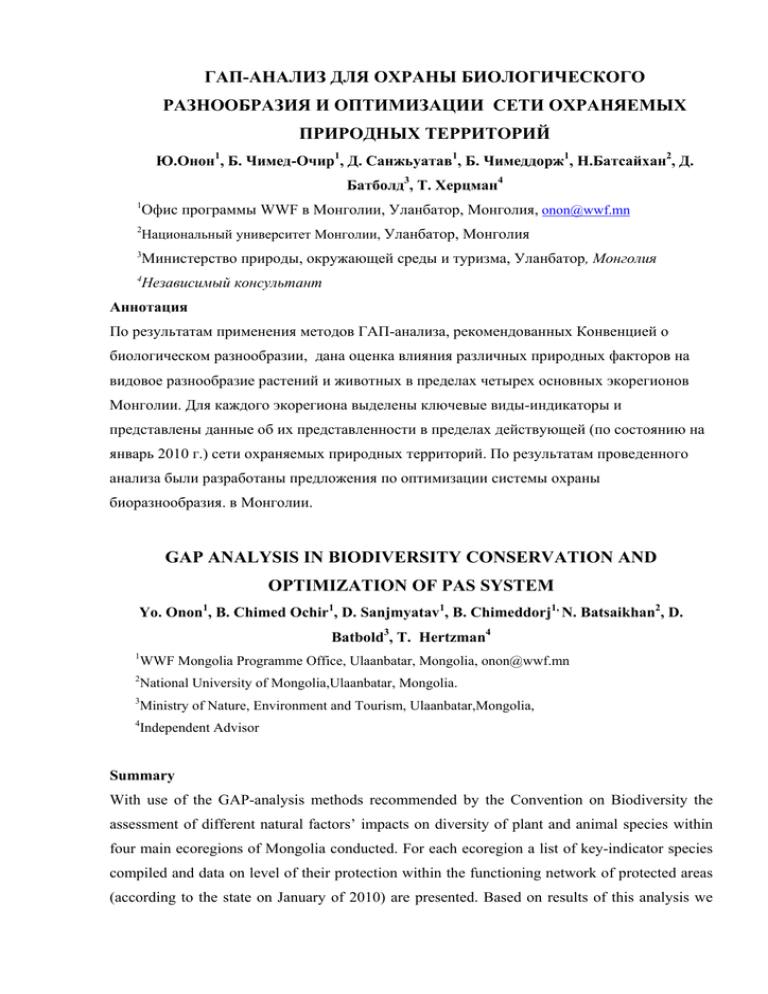
ГАП-АНАЛИЗ ДЛЯ ОХРАНЫ БИОЛОГИЧЕСКОГО РАЗНООБРАЗИЯ И ОПТИМИЗАЦИИ СЕТИ ОХРАНЯЕМЫХ ПРИРОДНЫХ ТЕРРИТОРИЙ Ю.Онон1, Б. Чимед-Очир1, Д. Санжьуатав1, Б. Чимеддорж1, Н.Батсайхан2, Д. Батболд3, Т. Херцман4 1 Офис программы WWF в Монголии, Уланбатор, Монголия, onon@wwf.mn 2 Национальный университет Монголии, Уланбатор, Монголия 3 Министерство природы, окружающей среды и туризма, Уланбатор, Монголия 4 Независимый консультант Аннотация По результатам применения методов ГАП-анализа, рекомендованных Конвенцией о биологическом разнообразии, дана оценка влияния различных природных факторов на видовое разнообразие растений и животных в пределах четырех основных экорегионов Монголии. Для каждого экорегиона выделены ключевые виды-индикаторы и представлены данные об их представленности в пределах действующей (по состоянию на январь 2010 г.) сети охраняемых природных территорий. По результатам проведенного анализа были разработаны предложения по оптимизации системы охраны биоразнообразия. в Монголии. GAP ANALYSIS IN BIODIVERSITY CONSERVATION AND OPTIMIZATION OF PAS SYSTEM Yo. Onon1, B. Chimed Ochir1, D. Sanjmyatav1, B. Chimeddorj1, N. Batsaikhan2, D. Batbold3, T. Hertzman4 1 WWF Mongolia Programme Office, Ulaanbatar, Mongolia, onon@wwf.mn 2 National University of Mongolia,Ulaanbatar, Mongolia. 3 Ministry of Nature, Environment and Tourism, Ulaanbatar,Mongolia, 4 Independent Advisor Summary With use of the GAP-analysis methods recommended by the Convention on Biodiversity the assessment of different natural factors’ impacts on diversity of plant and animal species within four main ecoregions of Mongolia conducted. For each ecoregion a list of key-indicator species compiled and data on level of their protection within the functioning network of protected areas (according to the state on January of 2010) are presented. Based on results of this analysis we elaborated recommendations for the optimization of system of biodiversity conservation in Mongolia. The Gap analysis is based on an analysis of international principles, designed within the CBD cooperation and international forums of scientists. All methods have been carefully adapted to the Mongolian context and performed by Mongolian experts. The system of PAs in Mongolia contains 71 areas (plus the four PAs added in January 2010) that are legally protected under the Mongolian Law on Special Protected Areas. The other category of analysis is related to the ecological aspects. In this we examine ecoregions, ecosystems and species, analyzing the effectiveness from an ecological representativeness point of view. The GAP analysis we have endeavoured to find, in close dialogue with Mongolian researchers and experts, an even broader system of ecologically recognisable eco-regions. This dialogue has concluded that Mongolia can be divided into 4 eco-regions for the purpose of this GAP analysis. The selected ecosystems cover all altitudes from lowest points (Khukh Nuur) to the highest mountain peak, the Tavanbogd Uul in the Altai Mountains, as well as all levels of aridity from deserts in the Gobi to the great lakes such as Khovsgul Nuur. Each eco-region and the ecosystems have been analyzed and conclusions have been made based on scientific data and GIS based information. The presence of the 19 matrix and 4 patch ecosystems in the existing PA network has been analysed within the GAP analysis. We have performed an analysis on the finest level- that is species. This would be the ultimate level of analysis, if it was possible to cover all species of Mongolia. We have selected a number of species as key representatives of each of the 4 eco- regions. The main criteria for selection were not only vulnerability or presence on the Mongolian Red List, but also the ecological function in the ecosystem and the population trends. The following criteria were considered: Distribution patterns, conservation statues, threatened species, statues in the ecosystem, population statues, vulnerability, representative species, and global importance. Based on the abovementioned criteria, a set of species or communities were selected for each eco-region. These species can be seen as the selected “representatives of the biodiversity” in the respective eco-region. Based on the presence, non-presence and potential habitat of those species it was possible to create a better understanding of what gaps there are in the current PA system. It should also be noted that mapping at this fine filter level has its weaknesses. The first weakness is the restricted availability of reliable field observations. This is a common problem in Mongolia and within the PA system as such. The country area is enormous and human settlements are often scarce. Further, the populations of species are often low by nature and the number of observing and reporting field biologists is limited. This means that for the mapping within the GAP analysis it was necessary to create a system of maps reflecting the potential habitats and distribution of the selected species rather than documented presence. For each selected species, the known distribution was described in terms of ecosystem, landscape, elevation, vegetation and soil. Based on this combination of field observations and scientific reports we were able to create a map for each of the 38 species and 9 plant communities showing the potential distribution. We have developed recommendations of biodiversity conservation for decision makers.
